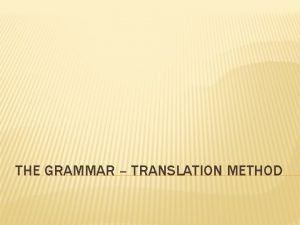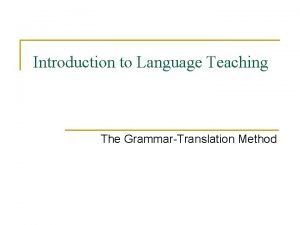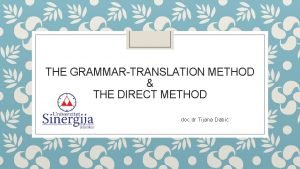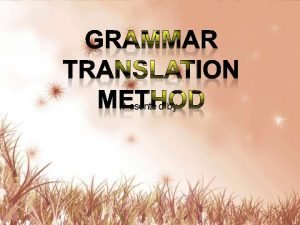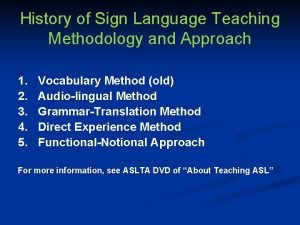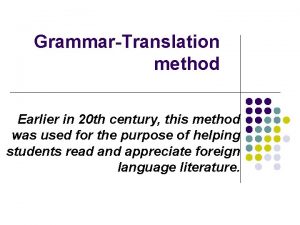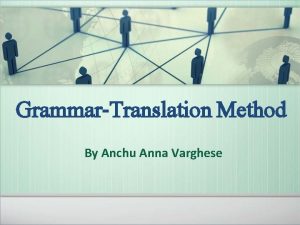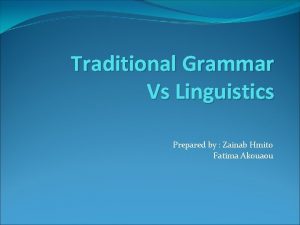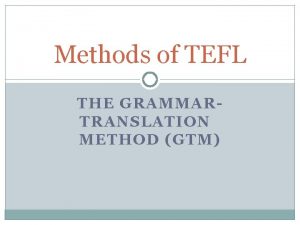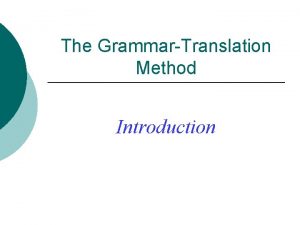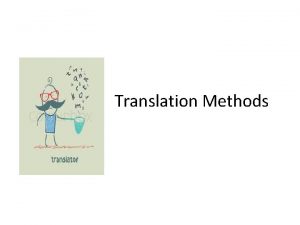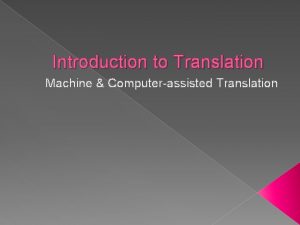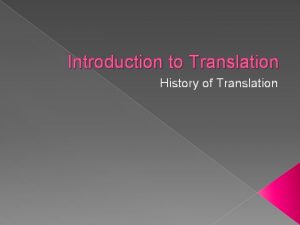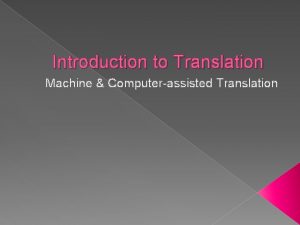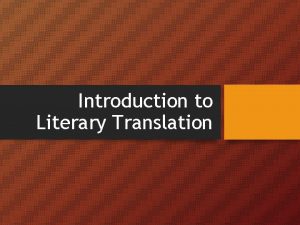THE GRAMMAR TRANSLATION METHOD INTRODUCTION The grammartranslation method












- Slides: 12

THE GRAMMAR – TRANSLATION METHOD

INTRODUCTION � The grammar-translation method of foreign language teaching is one of the most traditional methods, dating back to the late 19 th and early 20 th centuries. � It is also called the classical mehod as it was used to teach classical languages, Latin and Greek.

PRINCIPLES Teacher’s Objective To enable students to read and translate target language literature which is considered superior to spoken language. It also aims at further students’ general intellctual development. 1.

2. Teacher and students’ roles : Their roles are the traditional one; he teacher has the authority and the students are passive taking everything from the teacher. 3. The teaching/learning characteristics Students are taught through reading and translating. The target language grammar is taught deductively; they are given the grammar rules and apply them to examples, are told to memorize them, learning verbs conjugation and memorizing vocabulary.

4. Intercation Most of it is teacher-student ype 5. Students’ feelings : Not considered 6. Language areas and skills emphasized Vocabulary and grammar Reading and writing Little attention is given to listening and speaking Pronunciation is not taught. 7. How are language and culture viewed Literary language is superior to the spoken one. Culture is viewed to consist of literature and fine arts.

8. The role of the students’ native language The students are taught through translation to the mother tongue. The language used by the teacher in explanation is mostly the native language. 9. Evaluation The teacher evaluates students through translating texts from TL into the NL and vice versa. Besides There are questions about grammar and vocablary.

10. Error Correction It is mainly done by the teacher as it is very important that the students get the correct answer.

TECHNIQUES 1. 2. A. B. C. Translation Reading comprehension questions … They are sequenced to be in three groups Questions asking for information contained in the passage Questions depend on inferences Questions require students to relate the passage to their own experience

3. Synonyms/Antonyms 4. Cognates 5 Deductive Application of Rules : The teacher explains the rules and gives examples. Once students understand the rules, they are asked to apply them to some different examples. 6. Exercises ( Fill-in-the-blanks ) 7. Memorization ( lists of target language words with their meanings and verbs conjugation ) 8. Use words in sentences ( making sentences including the new words being learned ) 9. Composition ( asking students to write a composition based on idea taken from the reading passage or asking the to write a précis of the reading passage )

THE ADVANTAGES & DISADVANTAGES OF GRAMMAR – TRANSLATION METHOD Advantages ( Merits ) 1. It can be useful with large classes 2. It is beneficial to use in classes where there are students of various levels 3. The students understand things easily 4. It doesn’t consume time in finishing the syllabus 5. In the Grammar-Translation Method, comparison between two languages helps students to have a better understanding of the meaning of abstract words and complicated sentences. 6. Systematic study of grammatical rules plays an important role in fostering students’ ability of reading comprehension and producing grammatically correct sentences. It has special importance for students in teachers’ colleges to get a good mastery of the grammar system of the target language. 7. The focus on understanding literary texts provides the situation in which reading and writing abilities are well trained. 8. Least stressful for students as they use their native language. v

DISADVANTAGES ( DEMERITS ) 1. 2. 3. 4. 5. 6. 7. 8. 9. 10. No oral work is done Teaching pronunciation is totally neglected Everything is done in the native language, whereas the target language is ignored Main emphasis is given on the rules of grammar Students learn mainly through translation No speaking in the target language is possible, the only thrust is on reading Everything is presented by the teacher No possibility for the students to develop power of thinking in the target language the texts are mostly taken form literary works. The language learned often doesn’t meet the practical needs of the learners. Memorizing grammar rules and bilingual word lists does not motivate students to actively communicate in the target language.

ACTIVITY Q 1. The Grammar – translation method teaches students about the target language, but not how to use it. Explain Answer : It is observed that many foreign language learners know the rules of the target language, and even they are able to correct the ungrammatical sentences. However, those students face difficulty in communicating with others in the foreign language. Q 2. What are the clues that this method had its origin in the teaching of the classical languages, Greek and Latin ? Answer :
 Merits of grammar translation method
Merits of grammar translation method Grammar translation method introduction
Grammar translation method introduction Direct method and grammar translation method
Direct method and grammar translation method Grammar translation method techniques
Grammar translation method techniques Grammar translation method examples
Grammar translation method examples Gouin and the series method
Gouin and the series method Grammar translation method examples
Grammar translation method examples Grammar translation method
Grammar translation method Left linear grammar
Left linear grammar The characteristics of traditional grammar
The characteristics of traditional grammar Type 0 grammar is called unrestricted grammar
Type 0 grammar is called unrestricted grammar Right linear grammar to left linear grammar
Right linear grammar to left linear grammar Semantic and communicative translation
Semantic and communicative translation
